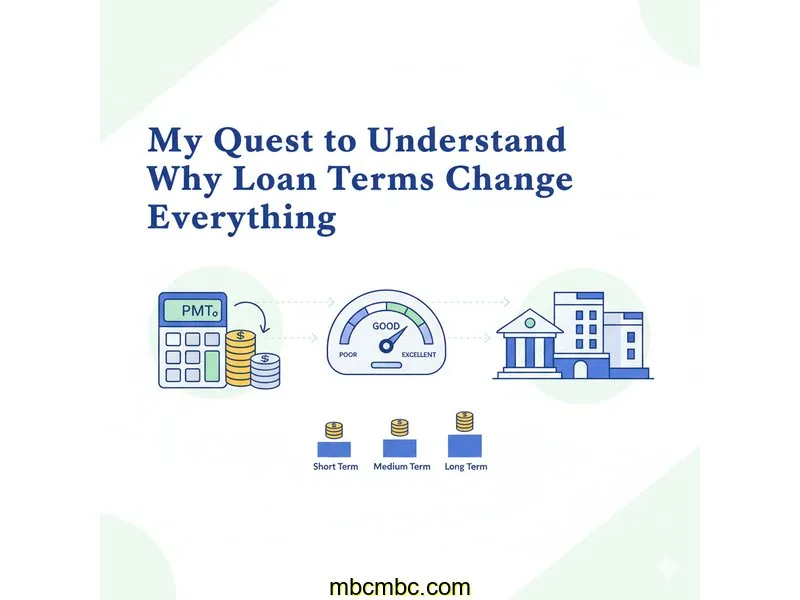
Auto Loan Calculator
Calculate payments over the life of your Loan
Home Blog Privacy Terms About Contact
Calculate payments over the life of your Loan
Home Blog Privacy Terms About ContactPublished on October 14, 2025

It all started with a simple conversation. A friend and I were talking about a recent purchase they made, and the topic of their loan came up. They mentioned their monthly payment, and I was genuinely surprised. It was significantly lower than what I would have expected for a similar amount. For a moment, I thought they had discovered some secret to borrowing money. But then a question popped into my head: how is that possible? If the loan amount and interest rate are similar, how can the monthly payment be so different?
That single question sent me down a rabbit hole. I’ve always been curious about how things work, and the math behind loans felt like a black box I was determined to open. My initial goal wasn't to find the "best" loan, but simply to understand the mechanics. Why did stretching out a loan seem to make it cheaper month-to-month, and what was the hidden trade-off? Was I missing a crucial piece of the puzzle?
My first stop was a handful of online loan calculators. I started plugging in numbers, but I was only looking at one result: the estimated monthly payment. I treated it like a high score in a video game, trying to get that number as low as possible. I wasn't really learning; I was just punching in numbers and watching one field change. It felt like I was reading only one word on a page and trying to understand the whole story. I knew I was missing the bigger picture, but I wasn't sure what to look for.
This article is the story of that learning process. It's about my journey to connect the dots between the monthly payment, the loan term, and the total cost. This is about understanding how calculations work, not financial advice. It’s my personal log of going from confused to confident in reading the story that the numbers were trying to tell me all along.
My initial confusion was rooted in a very human instinct: focusing on immediate, tangible numbers. When I started experimenting with calculators, I set up a hypothetical scenario to match the conversation that sparked my curiosity. I imagined I needed a loan for $14,850 at an interest rate of 7.2%. The first thing I did was enter these numbers and select a 3-year (36-month) term.
The calculator spit out a monthly payment of around $460.08. "Okay," I thought, "that's a clear number." But then, remembering my friend's lower payment, I changed just one variable: the loan term. I switched it from 36 months to 5 years (60 months). The result was dramatic. The new monthly payment was about $295.34. My immediate reaction was, "Wow, that's a difference of over $164 every month! This must be the better option."
For a while, I was stuck on that single data point. The allure of having an extra $164 in my monthly budget was powerful. I ran the calculation again and again, confirming the numbers. I thought I had solved the puzzle: a longer term equals a lower, more manageable payment. It felt so simple, but a nagging feeling told me it couldn't be the whole story. Where did that money go? It felt like a magic trick, and I wanted to understand how it worked, not just applaud the result.
My frustration grew because I knew I was missing something fundamental. I was looking at the calculator's dashboard but ignoring most of the gauges. The tool was giving me a complete picture, but I was fixated on one corner of the screen. I started clicking around, opening up details like "amortization schedules" and looking for other output fields. That's when I saw it, tucked away near the monthly payment: a field labeled "Total Interest Paid." This was the gauge I had been ignoring, and I soon discovered it was the most important one of all.
The breakthrough didn't come from a complex formula, but from a simple act of comparison. Instead of running one calculation at a time, I decided to put the two scenarios side-by-side. I opened two browser tabs with the same calculator and entered the exact same loan amount ($14,850) and interest rate (7.2%). In one tab, I set the term to 36 months. In the other, 60 months. Then, I meticulously wrote down all the results, not just the monthly payment.
Seeing the numbers laid out in a simple table was the "aha!" moment I had been searching for. The math suddenly stopped being abstract and became a clear, undeniable story about trade-offs. The lower monthly payment wasn't a magic trick; it was a choice with a very real, calculable consequence. That consequence was the total amount of interest I would pay over the life of the loan.
My first big realization was that the loan term wasn't just a passive number; it was an active multiplier. Because interest is calculated on the remaining balance over time, every extra month on the loan is another opportunity for interest to accrue. The extra 24 months in the longer-term scenario weren't free—they each came with an interest cost attached.
This experience fundamentally changed how I interact with loan calculators. I trained myself to look at the outputs in a new order. Instead of looking at the monthly payment first, I now go straight to the "Total Interest Paid" field. This number tells me the actual cost of borrowing the money. The monthly payment is still important for budgeting, but I now see it as a consequence of the two bigger factors: the term and the total interest.
To make sure this wasn't a fluke, I started running more scenarios. I tried a smaller loan amount, like $9,500 at 8.1% interest. I compared a 48-month term against a 72-month term. The pattern was identical. The 72-month loan had a much lower monthly payment, but the total interest paid was thousands of dollars higher. This repeated testing solidified my understanding. The relationship between term length and total interest was a fundamental principle of how this math worked.
This entire journey was about building my own financial literacy, one calculation at a time. It wasn't about finding a "good" or "bad" loan, but about understanding the mechanics so I could interpret the numbers for myself. Here are the key lessons I learned about the calculations themselves:
As I was going through this process, I had a lot of questions. Here are a few I managed to answer for myself, focusing strictly on how the calculations and tools work.
From a calculation standpoint, the loan term is the divisor. You are taking the total amount to be repaid (principal plus all the interest) and spreading it across a certain number of months. A higher number of months (a longer term) means each slice, or payment, will be smaller. A shorter term means fewer, larger slices.
This was my biggest question. The reason is that interest is calculated periodically (usually monthly) on the outstanding loan balance. With a longer loan, the principal balance decreases more slowly. This means that for many more months, you are paying interest on a larger remaining balance compared to a shorter-term loan.
In my learning journey, I concluded that the single most important field for understanding the cost is "Total Interest Paid." The monthly payment is critical for understanding affordability and cash flow, but the total interest figure shows you the actual price tag of borrowing the money over the entire term.
Yes, this is what an "amortization schedule" or "payment schedule" shows. Most good online calculators have a feature to display this table. It breaks down every single monthly payment into how much of it goes toward paying down the principal and how much is for interest. In the beginning of a loan, a much larger portion of your payment goes to interest.

My goal was to solve a puzzle about a lower monthly payment, and in the end, I learned something far more valuable. I learned that the numbers in a loan calculation tell a story, and the most important skill is learning how to read the whole story, not just the headline. The monthly payment is the headline—it grabs your attention. But the total interest paid is the actual plot, revealing the full cost of the journey.
Playing with online calculators, changing one variable at a time, and watching how it affected all the other numbers was the key. It transformed these tools from mysterious black boxes into powerful educational instruments. It's a process I'd encourage anyone to try—not to make a specific decision, but simply to build the confidence that comes from understanding the math for yourself.
My biggest takeaway is that there is no "magic" in loan math, only trade-offs. Understanding those trade-offs is the foundation of financial literacy. A lower monthly payment feels good, but knowing exactly what it costs in the long run feels even better, because it's the feeling of genuine understanding.
This article is about understanding calculations and using tools. For financial decisions, always consult a qualified financial professional.
Disclaimer: This article documents my personal journey learning about loan calculations and how to use financial calculators. This is educational content about understanding math and using tools—not financial advice. Actual loan terms, rates, and costs vary based on individual circumstances, creditworthiness, and lender policies. Calculator results are estimates for educational purposes. Always verify calculations with your lender and consult a qualified financial advisor before making any financial decisions.